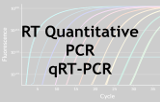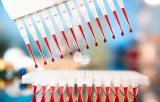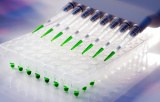
Quantitative RT-PCR - qRT-PCR
RT-qPCR is a technique which makes it possible to make a quantitative PCR (polymerase chain reaction) from an RNA sample. RNA is first retrotranscribed by an enzyme called reverse transcriptase, which allows the synthesis of the complementary DNA (cDNA). The latter is then used to carry out a quantitative PCR. Reverse transcriptase or reverse transcriptase (RT) is an enzyme used by retroviruses and retrotransposons that transcribe the genetic information of viruses or retrotransposons from RNA to DNA, which can integrate into the genome of the host.
RT-qPCR has been developed to use RNAs as a PCR amplification matrix. It is certainly the most sensitive method for detecting (and possibly quantifying) messenger RNAs at the level of an organ, tissue or cell. It is also used for the construction of cDNA libraries, sorting of mRNA (Differencial Display RT-PCR) as well as the construction of DNA probes.
Quantitative PCR or real-time qPCR is a particular method of polymerase chain reaction to measure the initial amount of DNA. In fact, quantitative PCR measures the number of amplicons (DNA portion defined by a pair of primers).
It enables continuous monitoring ("in real time") of the PCR amplification process by detecting the fluorescence emitted by the neo-formed PCR products.
The profile of a conventional quantitative PCR reaction can be broken down into 3 steps:
- A first step known as background noise: the amount of amplified fragment is insufficient to generate a fluorescent signal greater than the background noise (and therefore the fluorescence generated).
- A second step of exponential phase of growth: the quantity of amplified fragment generates a fluorescent signal higher than the detection threshold of the apparatus, and then the number of amplified products doubles on each cycle. In logarithmic coordinates, this phase is represented by a line.
- A final stage of the plateau phase: certain components of the reaction (and in particular the number of available Taq molecules) become limiting. The system no longer allows exponential amplification.
The detection can be carried out using SYBR green, a fluorescent organic compound which binds to nucleic acids, or probes, Taqman or FRET.



